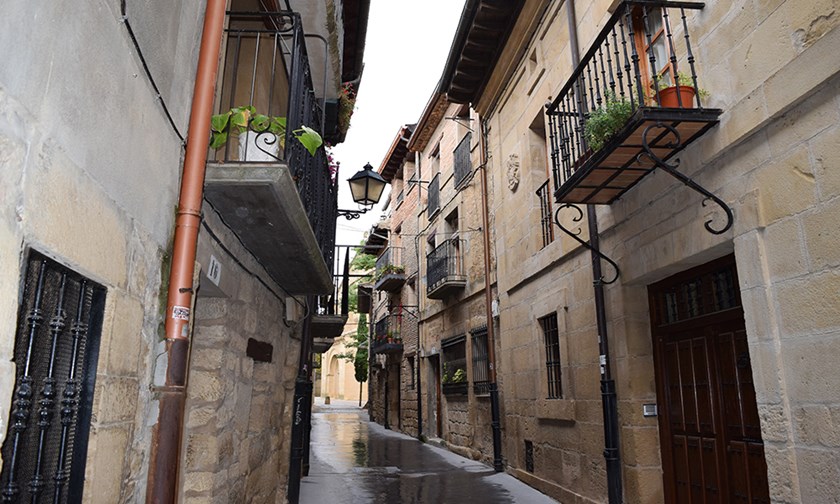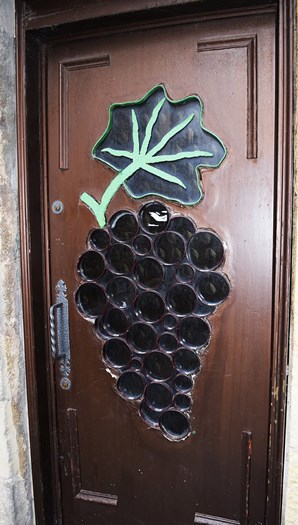LAGUARDIA, BASQUE COUNTRY, SPAIN - A cloud of doubt hangs over Juan Manuel Lavín Santamaria’s head as he surveys the dark sky forming above this picturesque medieval Basque town.
“This does not look good for the festival,” says the portly man who worries the threatening weather will interrupt the area’s annual wine festival to be held later on this mid-September day in neighbouring Samaniego.
“I will cross my fingers and hope for the best,” says Juan Manuel, manager of the award-winning Bodega Villa Lucia, one of the many vineyards nestled in beautiful Rioja Alavesa, a region in Álava province that produces the famed Rioja wine. Rioja Alavesa spreads out in all directions from the base of the majestic Cantabrian Mountains, which shelter this marvellous micro-climate region.
As a light drizzle begins to fall, Juan Manuel suggests I visit the famous tunnels under Laguardia’s Old Town where “at least you will be dry.”
Laguardia, now the capital of this region, is a former walled city that was built primarily for defensive purposes in the 14th century. It’s nicknamed the “honeycomb” town because of the labyrinth of tunnels under it. Each of the homes had one because they served as escape routes when the town was attacked, which apparently was quite often. Later, in peaceful times when the wall came down, most of the tunnels — about 300 — were converted into storage rooms. Some, though, were turned into wine cellars.
I trudge up a steep hill leading to the Old Town, which sits 635 metres above sea level, and when I reach the top I’m rewarded with spectacular panoramic views of the lush valley, where vines are heavy with fruit on the eve of the harvest.
A sign hanging over one of the five entrances to the town reads: “Peace to those who arrive here. Health to those who live here. Happiness for those who depart here.”


Above: The whole area around Laguardia likes to get involved in the annual wine festival.
Lovely Laguardia is one of the most popular tourist towns in the Basque country and is a favoured spot for cyclists who journey along the romantic Rioja Alavesa Wine Route.
The compact Old Town features just a few narrow streets, all lined with handsome sandstone homes, quaint restaurants whose bar tops are always filled with plates of pintxo (pincho) — yummy Basque tapas — and a couple of chic hotels where cyclists like to spend the night before returning to the wine route.
One of the five cellars in the Old Town still used for aging the grape is owned by the Bodega Carlos San Pedro, a family-run boutique winery which offers tours of their tunnel and some samplings, of course.
Carlos himself welcomes us to his “cueva” and cautions our small group not to “hit your head on the low hanging beams” as we make our way down some narrow stairs into the dark, musty cellar eight metres below the street.
“Our family has been storing wine in this cave for over 300 years,” says the charming Carlos, who informs us there’s still some bottles tucked away in the cave’s vaults that are over 100 years old. “But they are no longer drinkable,” he laments.
The family’s main vineyard clings to the slopes surrounding Laguardia and “we still pick the grape by hand each fall,” says the informative vintner as he uncorks a bottle of one of his family’s best vintages for us to sample.
“The caves offer perfect conditions for aging wine — the cellar is a constant 14C year round with a humidity level of between 80 and 85 per cent.
“There’s no vibration or noise down here and the darkness helps the wine to age better in the bottle,” he tells us.
The grape of choice is this area is the hearty tempranillo, which features a relatively neutral profile but produces some full bodied reds that the Basque country is noted for. Tempranilloit grapes actually ripen several weeks earlier than most so they can be harvested well before the cool winter winds blow into the valley off the Cantabrian Mountains.
Carlos tells us his cellar can hold up to 50 barrels and that his family produces about 50,000 bottles of wine each year — “a very small production compared to our neighbours like Bodega Villa Lucia; they produce over 500,000 bottles a year.”

Above: Family-run wineries still like to store their barrels in the caves under Laguardia.
Up until 2004, the family used to extract the wine from the grape using primitive presses, but now they have turned to more modern methods — “the only thing that we keep traditional is the aging of the wines for about five years in these cellars,” says Carlos as the tour ends.
Emerging into the daylight, I see a crowd gathered in Laguardia’s small square waiting for its famous Pendulum Clock to chime. When it does, three figures appear dancing in traditional costume to a popular Basque song. On the Feast of St. John each year, the whole town — about 1,500 residents — rallies around the clock and local girls dressed in the costumes of their ancestors dance through the narrow streets.

Above: Laguardia's town clock is one of the most famous in Basque country.
The fashionable boutique Hotel Los Parajes just off the main square is one of the most popular places to stay in the wine region. Two homes have been joined together to make one amazing 18-room hotel, featuring cozy wine bars in their cellar and one of the best spas in Basque country.
As we leave Laguardia headed for the wine festival in Samaniego, a rainbow suddenly flashes across the valley and the sun begins to poke through the low hanging clouds. I know my friend Juan Manuel must be smiling somewhere.
There are over 580 wineries in Rioja Alavesa and 80 in tiny Laguardia alone, and the whole valley seems to have converged on Samaniego for the wine festival, which rotates from town-to-town each year in what Carlos describes as our “dreamland for wineries.”
While Samaniego may not offer the same charm as Old Town Laguardia, it’s known as one of the most hospitable places in the area and many foreigners have moved here to enjoy its ambiance and temperate climate.
As I enter the city, I’m handed a wine glass and told by a charming young woman that I can get it filled at wine stations set up throughout the town for the festival.
Showcasing regional foods is also a big part of the festival and the Basque sausages being grilled on open fires fills the air with a spicy aroma.
The streets of Samaniego are packed with revellers — many local politicians are in attendance because the harvest festival is where you must be seen. Everyone is having a good time singing and dancing and the wine is now flowing freely.
The variety of wines varies and one local man cautions me: “to understand good wines, you have to taste a lot of bad wine.”


Above: The town's backstreet homes are decorated with the grape.
One of the best I sample is a young Vendimia from a local winery called Baigorri. I’m so impressed that later I visit the modern facility perched on a hill overlooking the valley and Matthias Lange, a manager at the winery, tells me his vintages are very much like a Beaujolais but “our wines age much better.”
Some of the wineries in the area are modern wonders, designed by the likes of legendary Canadian architect Frank Gehry. Gehry, who’s revered in Basque country because of his design of the Guggenheim Museum in Bilbao, also created the main building at the Bodge Marques de Riscal and the flowing titanium facade of the winery is every bit as impressive as the Guggenheim.
When I arrive back at the Villa Lucia winery — its hotel and spa complex draws people from as far away as England for weekend stays — Juan Manuel is there to greet me with a glass of his own excellent wine.
“Let us toast the wine festival and the good weather,” says Juan Manuel.
There is much to celebrate in this Basque wine region.
Information
The easiest way to get to the Basque country from Canada is with Air Canada or British Airways via London. Bilbao is only an hour’s flight from Heathrow. / Hotel Los Parajas is a great place to base yourself in Leguardia. It has a charming wine cellar bar and some fascinating rooms looking out over the wine valley. www.hospederiadelosparajes.com / For more information on the wine region, go to the Basque Tourism website: www.basquecountrytourism.eus